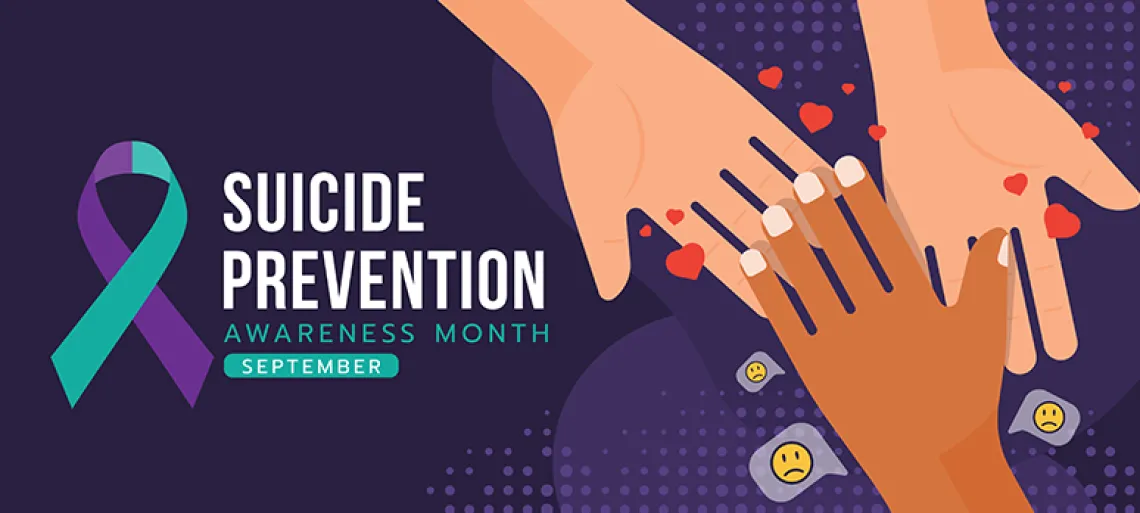
Each year, September is recognized as Suicide Prevention Month in the United States. This month provides individuals and organizations with a dedicated space to raise awareness, share resources, and focus on helping those reaching out. As stated in the Surgeon General’s Call to Action to Implement the National Strategy for Suicide Prevention, “Although suicide is a complex behavior that can be influenced by many different factors, suicide is preventable. Suicide prevention requires a comprehensive approach that combines multiple strategies to reduce risk and strengthen protective factors at the individual, relationship, community, and societal levels.”
The consensus from suicide prevention organizations is that we need to talk about suicide with those we love and are in contact with. That conversation can be tough, but some of the best tough conversations can lead to better outcomes. As a suicide loss survivor and someone with a history of suicidal ideation and an attempt, I know that talking can be the first step to healing, hope, and recovery.
Suicide affects all populations, and some more than others. Below is some high-level information about suicide among different age groups. For more specific information, you can explore and learn more at the following organizations:
- U.S. Centers for Disease Control and Prevention (CDC)
- American Foundation for Suicide Prevention (AFSP)
- Suicide Prevention Resource Center (SPRC)
Young people
- Stats:
- After no significant change between 2001 and 2007, the suicide rate among young people ages 10‒24 increased 62% from 2007 through 2021, from 6.8 deaths to 11.0 per 100,000.1
- LGBTQ+ young people are more than four times as likely to attempt suicide than their peers.2
- 41% of LGBTQ+ young people seriously considered attempting suicide in the past year, including roughly half of transgender and nonbinary youth.3
- What you can do:
- Talking to young people about this topic may be difficult, but it’s necessary. Luckily, amazing organizations like The Trevor Project, the 988 Suicide & Crisis Lifeline, and the American Psychosocial Association, among others, provide valuable resources to help guide you in your conversation with young people and resources for young people to connect and get help when needed.
Adults
- Stats:
- Adults aged 35–64 years account for 46.8% of all suicides in the United States, and suicide is the 8th leading cause of death for this age group.4
- Among men in this age group, suicide rates were highest for non-Hispanic American Indian or Alaska Native (AI/AN) men (41.3 suicides per 100,000), followed by non-Hispanic White men (35.7 per 100,000).5
- Among women in this age group, suicide rates were highest among non-Hispanic American Indian or Alaska Native women (12.8 per 100,000) and non-Hispanic White women (10.7 per 100,000).6
- What you can do:
- If you are worried about someone, one of the first things you need to do is talk to them. The American Foundation for Suicide Prevention (AFSP) offers resources on how to have an honest conversation and steps to take to help someone who may be struggling with thoughts of suicide.
- As adults, it is also important for us to advocate and vote for causes that are important to us. AFSP offers resources on how to take action to advocate for the passage of suicide prevention policies at the state and federal levels on the way to saving lives.
Older adults
- Stats:
- Adults aged 75 and older have one of the highest suicide rates (20.3 per 100,000). Men aged 75 and older have the highest rate (42.2 per 100,000) compared to other age groups. Non-Hispanic White men have the highest suicide rate compared to other racial/ethnic men in this age group (50.1 per 100,000).7
- What you can do:
- The webpage Suicide and Older Adults: What You Should Know provides insights on risk factors, warning signs, and how to support someone in this age group experiencing suicidal thoughts.
We need to keep talking about suicide even if the conversations are difficult. You can make a difference. September will end, but until we are in a world without suicide prevention, advocates will continue to fight against suicide. Join the fight this month and the future, and be the light for someone.
Additional Mental Health and Suicide Resources
- 988
- National 24/7 free and confidential support for people in distress, prevention, and crisis resources for you or your loved ones.
- Warm lines
- “A warmline is a phone number you call to talk with someone who can provide support during hard times. Whether you’re in crisis or just need someone to talk to, a warmline can help. Warmlines are staffed by trained peers who have been through their own mental health struggles and know what it’s like to need help.”
- ComPsych
- ComPsych offers free, confidential, short-term counseling to all benefits-eligible University of Arizona employees nationwide, their dependents, and members of their households.
- CredibleMind
- “CredibleMind is a free one-stop-shop digital platform that provides expert-curated and scientifically backed mental health self-care content. It's available to benefits-eligible employees and their households 24/7.”
- QPR training sessions
- “Just as people trained in CPR help save thousands of lives each year, people trained in QPR learn to recognize the warning signs of a suicide crisis and to question, persuade, and refer someone to help.”

